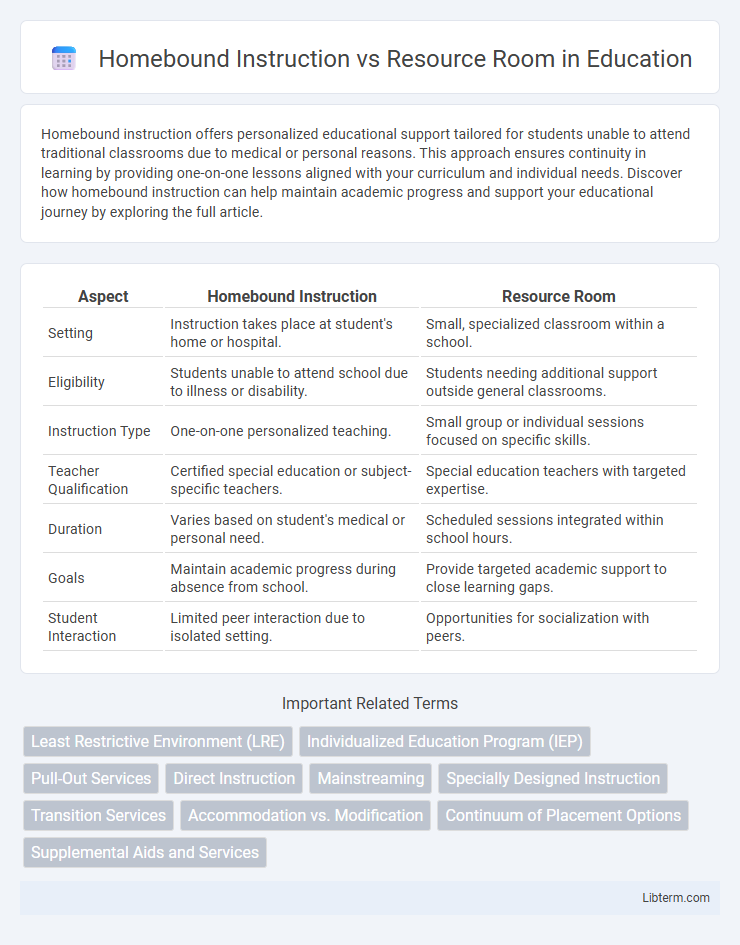Homebound instruction offers personalized educational support tailored for students unable to attend traditional classrooms due to medical or personal reasons. This approach ensures continuity in learning by providing one-on-one lessons aligned with your curriculum and individual needs. Discover how homebound instruction can help maintain academic progress and support your educational journey by exploring the full article.
Table of Comparison
| Aspect | Homebound Instruction | Resource Room |
|---|---|---|
| Setting | Instruction takes place at student's home or hospital. | Small, specialized classroom within a school. |
| Eligibility | Students unable to attend school due to illness or disability. | Students needing additional support outside general classrooms. |
| Instruction Type | One-on-one personalized teaching. | Small group or individual sessions focused on specific skills. |
| Teacher Qualification | Certified special education or subject-specific teachers. | Special education teachers with targeted expertise. |
| Duration | Varies based on student's medical or personal need. | Scheduled sessions integrated within school hours. |
| Goals | Maintain academic progress during absence from school. | Provide targeted academic support to close learning gaps. |
| Student Interaction | Limited peer interaction due to isolated setting. | Opportunities for socialization with peers. |
Understanding Homebound Instruction
Homebound instruction provides individualized education to students unable to attend school due to medical or psychological conditions, ensuring continuity of learning in a home or hospital setting. It involves tailored teaching approaches delivered by qualified educators, addressing specific health-related needs while aligning with the student's IEP or 504 plan. Unlike resource room services that support students within the school environment, homebound instruction offers flexible, one-on-one educational support outside traditional classrooms.
Defining the Resource Room Model
The Resource Room model provides specialized instruction within a designated classroom where students with disabilities receive targeted support tailored to their Individualized Education Programs (IEPs). This approach balances inclusion in the general education setting with focused remediation, typically for part of the school day. Resource Rooms emphasize skill development through small group or one-on-one instruction, promoting academic progress while maintaining social integration.
Eligibility Criteria: Who Qualifies?
Eligibility for Homebound Instruction typically includes students with medical conditions or disabilities preventing regular school attendance for extended periods, requiring individualized education plans (IEPs) or medical documentation. Resource Room services are designed for students with identified learning disabilities or special education needs who can attend school but require targeted support within a structured classroom setting. Both programs mandate evaluation by a multidisciplinary team to determine the appropriate placement based on the student's educational and medical needs.
Instructional Setting and Environment
Homebound instruction provides personalized education within the student's home or hospital, creating a quiet and distraction-free environment tailored to individual health needs. Resource rooms offer a specialized classroom setting in schools designed to support students with learning disabilities through targeted instruction and social interaction. Both settings prioritize individualized learning, but homebound instruction emphasizes isolation and health accommodations, while resource rooms foster peer engagement and collaborative learning.
Teaching Approaches and Methods
Homebound instruction employs individualized teaching approaches tailored to students unable to attend school due to medical or personal reasons, emphasizing one-on-one instruction and flexible pacing to meet specific needs. Resource room settings use specialized methods within a small group environment, providing targeted support in core academic skills while promoting peer interaction and collaborative learning. Both approaches integrate differentiated instruction techniques but vary in delivery, with homebound instruction focusing on personalized content access and resource rooms leveraging structured intervention strategies.
Academic Outcomes and Effectiveness
Homebound instruction provides personalized academic support in a one-on-one setting, often benefiting students with medical or special needs by accommodating their unique learning paces and environments, which can lead to improved individualized academic outcomes. Resource rooms offer small-group instruction targeting specific skill deficits, providing specialized teaching that enhances student engagement and mastery of curriculum standards within a more social learning context. Studies indicate resource rooms generally support better peer interaction and social skill development, while homebound instruction excels in customizing content delivery, making effectiveness dependent on student needs and instructional quality.
Social and Emotional Impact
Homebound instruction often limits students' social interactions, potentially increasing feelings of isolation and impacting emotional well-being negatively. Resource rooms provide a structured environment where students receive personalized academic support while maintaining social engagement with peers, fostering better emotional development. Research indicates that consistent peer interaction in resource rooms enhances social skills and reduces anxiety compared to the more isolated setting of homebound instruction.
Collaboration with Families and Professionals
Homebound instruction and resource room settings both emphasize collaboration with families and professionals to support student learning, yet differ in scope and interaction frequency. Homebound instruction requires intensive coordination among educators, healthcare providers, and families to tailor individualized lesson plans that address medical or mobility challenges directly at home. Resource room programs engage families and specialized staff through regular communication and joint progress monitoring, fostering a team approach that enhances skill development for students needing targeted academic support.
Transitioning Between Homebound and Resource Room
Transitioning between homebound instruction and resource room services requires careful coordination to ensure continuity of education for students with special needs. Individualized Education Program (IEP) teams must assess a student's progress, social readiness, and academic performance to determine the appropriate timing for transition. Effective communication among educators, parents, and support staff facilitates smooth reintegration and supports targeted interventions tailored to the student's evolving needs.
Choosing the Right Support for Student Needs
Homebound instruction provides individualized teaching for students unable to attend school due to health or personal reasons, ensuring they keep pace with the curriculum in a tailored environment. Resource rooms offer specialized support within the school, focusing on developing specific academic skills through structured, small-group sessions. Selecting the appropriate support depends on the student's medical condition, social needs, and learning style to optimize educational outcomes effectively.
Homebound Instruction Infographic

 libterm.com
libterm.com